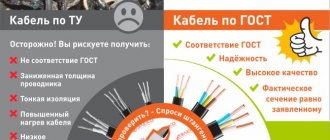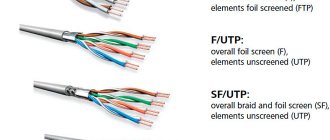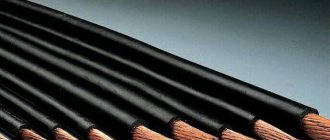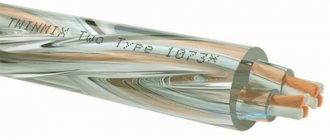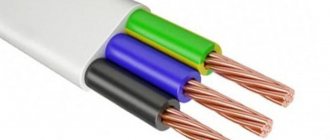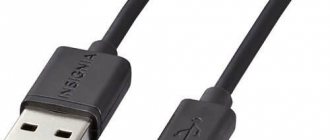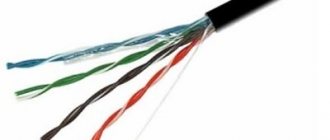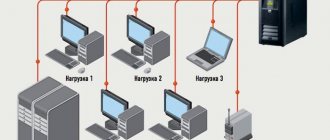The first thing you should know is that a high-quality cable must satisfy GOST. It is regularly updated and supplemented.
The last active one has the number GOST 31996-2012 -. Explanations and comments on the new standard -.
Some factories, wanting to save money, develop their own technical specifications that do not meet the standard and produce products according to them. It is this that in most cases causes short circuits and fires.
However, do not be confused, factories do not manufacture cables directly according to GOST. This is a common expression among electricians. In any case, all factories make cables according to specifications. They develop them themselves. Just what is written there is a big question.
As a result, such technical conditions can either be fully based on the requirements of the standard, or in some way circumvent them.
In other words, all cables comply with specifications, but not all specifications comply with GOST.
Some people don’t even suspect that all this should be produced according to some approved standards. How to decide what is better to purchase: GOST or TU cable?
Difference between GOST and TU cables
In Soviet times, factories always produced products in accordance with GOST. GOST is a state standard from which you have no right to deviate. If the product said it was a 4mm2 cable, then it really was a real 4mm2.
Much later, in order to increase the economic profit of the enterprise, their own technical conditions were invented. The technical specifications indicate the requirements for any substance from which the cable is made, as well as the procedures governing the implementation of these requirements.
On the one hand, there doesn’t seem to be much difference compared to GOST. However, this allowed the manufacturer to begin reducing the cross-section of the cores, the thickness of the insulation, etc. They simply issue technical specifications for one specific product and prescribe in them what they themselves require. As a result, you can observe the following difference between seemingly identical cable brands:
And all these deviations from GOST were prescribed by the plant in the technical specifications, thus allegedly not violating the standards.
There are two main methods used here:
- For example, you can seem to keep the cross-section, but save on burning copper, or add some impurities to it.
- The second method is that if you can provide sufficient resistance to the core, you are allowed to reduce its cross-section.
All this led to manipulation and dangerous savings in the manufacture of cable products.
When you think about saving when choosing a cable, know that there are two main violations when manufacturing it according to specifications:
- the cross-section of the cores is reduced
- the thickness of the insulating layer decreases
The main difference between SIP according to TU and GOST
Many may have a completely logical question - how to distinguish SIP created according to specifications and goods according to GOST? It is worth paying attention to several properties:
- Insulation. GOST indicates that it is made of light-stabilized cross-linked polyethylene, and not thermoplastic.
- Veins. Any type of SIP must have homogeneous cores made of aluminum or an alloy of this metal. There should not be a steel core inside the core. This is easy to determine visually; you just need to look at the wire in cross-section. The steel core will be in the center and its color will be darker. It is likely that if the product is old and has been left in the open air for a long time, rust may appear on it.
- Marking. A large number of manufacturing companies mark the cores in wires using strips of different colors. They can indicate the quality of SIP. According to the standard, their width must be at least 1 mm and be the same throughout the entire product.
In conclusion, we can conclude that if you need SIP wires to last the warranty period without emergencies and not require major repairs during maintenance, then you should buy cable products that fully comply with GOST. You should not skimp on wires and you need to carefully look at their characteristics and check certificates.
How to distinguish a quality cable
How can you quickly and easily determine which cable is GOST or non-GOST? To distinguish high-quality products from low-quality ones, always ask for a certificate of conformity when purchasing. Be sure to look for the technical specification number and its compliance with the state standard. Don’t trust those products that simply say “GOST” and that’s it.
Carefully examine the label on the cable spool or drum.
A tag is like a person’s passport. All information should be entered here:
- manufacturer
- date of manufacture
- batch number
- TU number and link to certificate
Also look for the EAC mark.
Its presence is a guarantee of product compliance with dozens of standards of the countries of the EurAsEC Customs Union, including several state standards.
Therefore, if it is there, then the cable is of high quality and safe.
No plant will voluntarily set such marks and fail to comply with their requirements. Otherwise, you can easily run into fines for breaking million-dollar contracts with large wholesalers.
Structural and electrical parameters
| Number and cross-section of cores, pcs. x sq.mm | Estimated weight, kg/km | Diameter, mm | Permissible current load, A | One-second short circuit current, kA | |
| with aluminum alloy core | with aluminum core, reinforced with steel wire | ||||
| 1x16 + 1x25 | 167,2 | 188,5 | 15,0 | 105 | 1,5 |
| 2x16 | — | 131,9 | 14,0 | 100 | 1,5 |
| 2x25 | — | 197,9 | 17,0 | 130 | 2,3 |
| 3x16 + 1x25 | 299,2 | 320,4 | 22,0 | 100 | 1,5 |
| 4x16 + 1x25 | 365,1 | 386,3 | 26,0 | 100 | 1,5 |
| 4x16 | — | 263,8 | 22,0 | 100 | 1,5 |
| 3x25 + 1x35 | 429,2 | 462,5 | 26,0 | 130 | 2,3 |
| 4x25 + 1x35 | 527,7 | 561,1 | 26,0 | 130 | 2,3 |
| 4x25 | — | 394,3 | 26,0 | 130 | 3,2 |
| 3x25 + 1x54.6 | 505,6 | — | 26,6 | 130 | 2,3 |
| 3x35 + 1x50 | 577,5 | 620,6 | 30 | 160 | 3,2 |
| 3x35 + 1x54.6 | 599,6 | — | 28,4 | 160 | 3,2 |
| 3x50 + 1x50 | 736,3 | 779,3 | 32 | 195 | 4,6 |
| 3x50 + 1x54.6 | 758,3 | — | 32,8 | 195 | 4,6 |
| 3x50 + 1x70 | 799,8 | 862,4 | 35,0 | 195 | 4,6 |
| 3x70 + 1x54.6 | 944,2 | — | 36 | 240 | 6,5 |
| 3x70 + 1x70 | 985,7 | 1048,3 | 37,0 | 240 | 6,5 |
| 3x70 + 1x95 | 1073,6 | 1160,3 | 41,0 | 240 | 6,5 |
| 3x95 + 1x70 | 1242,7 | 1305,3 | 41 | 300 | 8,8 |
| 3x95 + 1x95 | 1330,6 | 1417,3 | 45,0 | 300 | 8,8 |
| 3x120 + 1x95 | 1556,8 | 1643,5 | 47,0 | 340 | 7,2 |
Why are wires not made according to the standard?
This is done with one goal - to win the competition from other manufacturers by reducing the price of the product. The issue of reliability fades into the background here.
All this is designed for a technically illiterate buyer who, when he comes to the store, will choose exactly the product that is cheaper. And when purchasing it, the seller will also convince you that this cable meets certain technical conditions and is completely safe to use.
The big problem is that cables manufactured according to GOST requirements can very rarely be found in stores. The plant produces it for the most part for use on an industrial scale. Some stores sell such products only on order.
Based on the above, try not to think about what to choose: GOST or TU cable. It is definitely better to always purchase only one manufactured in accordance with GOST , and even if it is not available in the store, it is advisable to place an order and wait a few days rather than install products with pre-lowered characteristics.
The only advantage of a cable produced according to technical specifications is the ease of stripping the insulation.
With GOST wire, even when using electrician’s knives with a “heel,” big problems can arise.
Only well-known and high-quality brands do a good job - Knipex, Jocari. And then only on condition of well-sharpened blades.
And with TU, the insulation can be removed without any problems using any Chinese knives. In fact, it is a kind of heat shrink wrapped over several cores.
Specifications
| Parameter | Meaning |
| Rated alternating voltage frequency 50 Hz, kV | 1,0 |
| Operating temperature of the core, no more than °C | 90 |
| Core temperature in overload mode for 8 hours, no more than °C | +130 |
| Short circuit temperature for 5 seconds, no more than °C | +250 |
| Ambient temperature, min./max., °C | -50/+50 |
| Installation at a temperature not lower than °C | -20 |
| Service life, years | 25 |
| Warranty period, years | 3 |
Resistance of current-carrying conductors, no more, Ohm/km
| cross section, sq.mm | phase | carriers |
| 16 | 1,91 | — |
| 25 | 1,20 | 1,38 |
| 35 | 0,868 | 0,986 |
| 50 | 0,641 | 0,720 |
| 54,6 | — | 0,630 |
| 70 | 0,443 | 0,493 |
| 95 | 0,320 | 0,363 |
| 120 | 0,253 | 0,288 |
| 150 | — | 0,236 |
Tensile strength of load-bearing cores, not less, kN
| cross section, sq.mm | carriers |
| 25 | 7,4 |
| 35 | 10,3 |
| 50 | 14,2 |
| 54,6 | 16,6 |
| 70 | 20,6 |
| 95 | 27,9 |
| 120 | 35,2 |
| 150 | 43,4 |
Types of SIP and the difference
Today, the most widespread are 3 types of SIP with voltage 0.4 kV:
- SIP-1 is a wire with a bare, non-insulated load-bearing core. The supporting core is made of aluminum alloy, without any protective sheath.
- SIP-2 is a wire with an insulated load-bearing neutral core. Here the zero core is made of aluminum alloy covered with insulation on top. And the phase conductors are also insulated and twisted around it.
- SIP-4, SIP-5 - a wire with all four insulated conductors of the same cross-section made of aluminum.
Each plant must adhere to the current GOST when producing self-supporting insulated wires. However, some may deviate from the rules in order to save money. The result is different core material, different insulation, and different compaction coefficients.
Even the twists of the cores may be different - left-handed or right-handed.
Please note that in SIP1 and SIP-2 the load-bearing core must be made of aluminum alloy, which is less susceptible to stretching. As a result, during long-term operation of overhead lines, there will be no sagging of wires in anchor spans. Accordingly, there is no need to re-tighten and adjust the sag arms every 3-6 years during maintenance and major repairs.
SIP-4 is very susceptible to this because of the aluminum load-bearing cores. And you will have to deal with sagging here as well as on overhead lines with bare wires.
Operating conditions for SIP-2A wire:
For overhead power lines and branches to inputs into residential buildings, outbuildings in areas with temperate and cold climates, in an air atmosphere of types II and III according to GOST 15150-69.
| Technical and operational characteristics of SIP-2A wire | |
| Operating voltage | 0.6/1 kV |
| Ambient temperature during operation | from -50°С to +50°С |
| Relative air humidity (at temperatures up to +35°C) | up to 98% |
| Minimum cable laying temperature without preheating | -20 °C |
| Limit long-term permissible operating t° of cores: | |
| SIP-1 | +80 °С |
| SIP-2 | +70 °С |
| Maximum permissible heating temperature of cable cores in emergency mode (or overload mode): | |
| SIP-1 | +80 °С |
| SIP-2 | +130 °С |
| Maximum temperature of the cores under the conditions of non-ignition of the cable during a short circuit: | |
| SIP-1 | +80 °С |
| SIP-2 | +250 °С |
| Minimum permissible bending radius when laying | 7.5 outer diameters |
| Life time | 25 years |
| Warranty life of the cable | 3 years |
Features and Benefits
SIP-3 is characterized by the absence of a zero core, and it can be installed without additional supporting structures, such as a cable, cable, guy wire. The advantages of the wire include:
- high fire safety;
- the ability to carry out repairs on a working highway;
- no need to use insulator traverses;
- Possibility of installation in city conditions in compliance with safety and construction requirements;
- resistance to tensile stress prevents line breakage as a result of falling branches and other objects;
- expansion of the security zone;
- SIP and bare cable can be mounted on one support;
- the wires do not overlap, which eliminates short circuit;
- product reliability, uninterrupted operation of consumers;
- ease of care and maintenance;
- high speed of repair work;
- reduction of voltage losses on routes;
- excellent performance characteristics of SIP-3 wire;
- reducing costs when installing a new power line;
- mounted on low power transmission line supports;
- You cannot connect to the power line without special permission.
